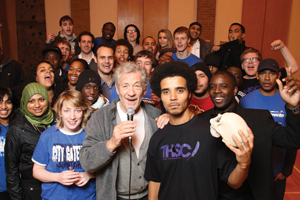Emma Macorison looks at how to get your message across to teenagers – who don’t necessarily engage with the arts in traditional ways.

If there has been a buzz word in our industry in recent years it has to be ‘engagement’. The arts and culture sector has, for a long time, been obsessed with young people: how can we reach them, how can we speak to them and, crucially, how can we engage with them? As we all strive to reach the youth audience, there can be a tendency to get bogged down in the misconception that young people aren’t interested in the arts, but that’s just not true. They are consuming culture on their own terms, and the truth is that some of you just aren’t invited to the party.
The problem is twofold: programming and communication. More and more organisations are thinking about how they can attract young people in order to diversify their audience. Sometimes they hit the mark, and sometimes they miss by a mile. Even when the content is spot on, sometimes the marketing campaign can let the whole project down. Arts Council England launched A Night Less Ordinary (ANLO) last year, a scheme that offers thousands of free theatre tickets to under-26 year-olds. The communications seemed to consist of using Metro as a media partner, a title aimed at commuters, which thereby missed out on the core youth audience and NEETs (young people Not in Education, Employment or Training). Leaflets were put in the foyers of participating theatres, thereby reaching people who were already walking though their doors. We have a monthly survey that asks 2,500 13–24 year-olds everything from their favourite soft drink to whether they used protection the last time they had sex. It’s an invaluable tool in understanding the mindset of young Britain – where they are, what they are doing and importantly, what makes them tick. A month after the launch of ANLO we asked our panel “Have you heard of a scheme where you can go to the theatre for free if you are under 26?” and only two respondents had. So the message (and marketing spend) is there, but it’s just not getting through.
BRIDGING A DIVIDE
I feel that this was a missed opportunity to target and engage teenagers who have never set foot in a theatre before. A peer-to-peer campaign, like the award winning Home Office anti-knife crime campaign It Doesn’t Have to Happen, would mean that the message was credible and spoke to young people in their own language to address some of their attitudinal barriers to the arts. A clever viral campaign, tapping into the media young people are using, rather than spending on traditional print media, could have led to a larger uptake from young people from all backgrounds. At the height of the swine flu pandemic last summer, we decided to demonstrate how even a mundane subject could be communicated to young people in a new and exciting way. Using our in-house team of creative apprentices we created a Funky House tune, Swine Flu Skank, which reiterated the government’s advice to “catch it, bin it and kill it”. A video was made and seeded online, and within 36 hours it was the global number one most viewed and most commented video on YouTube. To date it has had more than one million views and the track has been played on MTV, Radio 1 and clubs across the country, despite never being officially released.
UPDATING SHAKESPEARE
Last year we also worked on the launch of The Hip Hop Shakespeare Company with Sir Ian McKellen and MOBO award winning Hip Hop artist Akala. We reached stakeholders and funders via media including Newsnight Review and the broadsheets, but we also wanted to ensure we were reaching out to the audience who would ultimately benefit from their ground-breaking workshops, which explore the parallels between Hip Hop and Shakespeare – young people themselves. Using outlets like BBC 1Xtra, RWD Magazine and online forums, we ensured that the debut public performance at the Southbank Centre (as part of London 2012 Cultural Olympiad Open Weekend) was packed to the rafters. Daniel Clarke, aged 17 from Leyton, has lived in London all his life and had never even heard of the Southbank Centre, let alone been there. He had heard about the event on a music forum, where our e-marketing team had seeded topic threads and engaged with the audience. He went away genuinely enthused: “Did you know Shakespeare invented 1,700 words?”
So, programming designed for young people should also be communicated to them in a relevant way. ‘Traditional’ arts coverage is not reaching the young mass market, so it’s essential to use new media and clever PR to do so. A client recently challenged us to communicate with deprived teenagers who don’t consume traditional media or have access to the web, so we advertised on fried chicken take-away boxes and commissioned legal graffiti advertising on shop shutters. Makes sense doesn’t it? In the end, it’s like anything else – you get out what you put in. Ultimately, if you make the effort to talk to young people in their language it will pay dividends when it comes to attracting them to your space and engaging with them.
EMMA MACORISON is Associate Director at Love Communications, heading up the arts division.
E emma@wearelove.co.uk
T 020 7580 1852
W http://www.wearelove.co.uk
This week Emma attended a fashion show curated by Ape Media, saw ‘Handful of Henna’ at Arts Depot and attended the premier of ‘The Shouting Men’ in Leicester Square.



